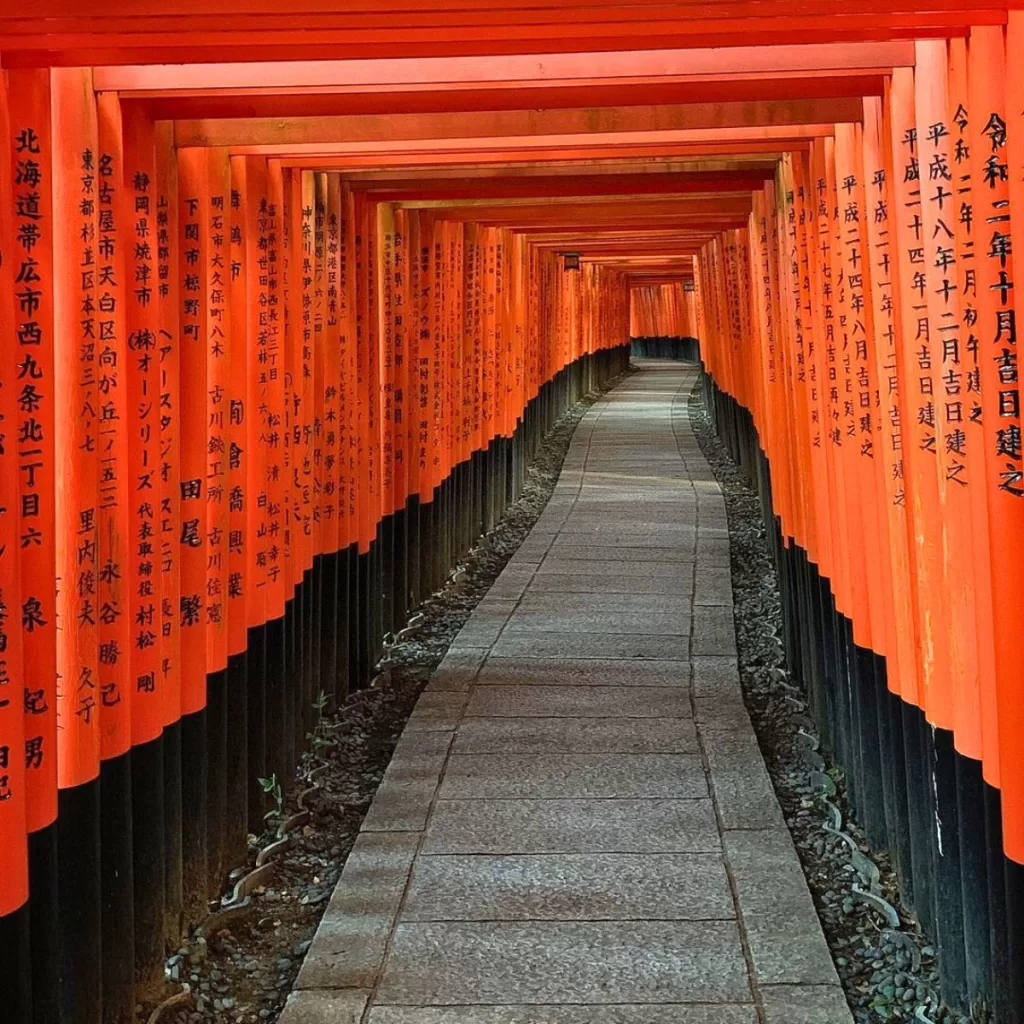Fushimi Inari Taisha: Kyoto’s Iconic Shrine of 10,000 Torii Gates
Fushimi Inari Taisha is a significant Shinto shrine in Southern Kyoto, Japan. Polish your lens and ready yourself for a visually spectacular experience as you delve into the history and fascination drawn by this iconic landmark.

History of Fushimi Inari Taisha
Fushimi Inari Taisha’s rich history dates back to 711, when the Shrine was founded. It is dedicated to Inari Okami, the Shinto god of rice, fertility, agriculture, and business; indeed, the Shrine became a focus point for merchants and manufacturers who donated Torii gates to get Inari Okami’s blessings. Combining natural wonder with immense cultural significance, it has attracted millions worldwide since it officially became important during the Edo period (1603-1868). Fushimi Inari shrine serves as a head shrine out of thousands of Inari shrines scattered throughout Japan.
Fushimi Inari Shrine
At the base of Sacred Mount Inari sits the magnificent Fushimi Inari Taisha Shrine – often simply referred to as Fushimi Inari. The shrine grounds encompass four kilometers of trails up high Mount Inari and feature thousands of vermilion torii gates that form an awe-inducing tunnel leading to the Shrine’s inner sanctuary.
The Shrine’s entrance is notably significant: a grand torii gate marks the entrance to the Shrine. The main Shrine lies behind this grand entrance gateway – all painted in vibrant vermillion. A color said to ward off evil spirits and misfortune.

Exploring The Thousand Torii Gates
Undeniably, one cannot discourse on Fushimi Inari Taisha without mentioning its most striking feature: Senbon Torii or ‘Thousand Torii Gates.’ Nestled serenely on Mount Inari’s slopes are these parallel rows of gates that appear like a mesmerizing red corridor. Each gate bears the donor’s name inscribed on them in black ink. Walking through this remarkable pathway offers unprecedented peace and tranquility unlike anywhere else.

Fox Statues Across The Shrine Grounds
Equally captivating are the hundreds of fox statutes found across the shrine grounds. Known as ‘kitsune’ in Japanese, they are considered messengers of the deity Inari and are heavily associated with this particular Shrine. As you visit Fushimi Inari Taisha, you will spot fox statues holding a key in their mouths – believed to be keys for rice granaries.
Hike to The Summit of Mount Inari
The iconic red torii gates pave the trail to Sacred Mount Inari’s summit. The hike takes about 2-3 hours while passing through serene forests and offers panoramic views over Kyoto once at the top. Be sure to wear comfortable footwear if undertaking this memorable journey!
Visit Fushimi-Inari-Taisha near Kyoto Station
Fushimi-Inari-Taisha is wonderfully accessible; it is located just outside JR Kyoto station – only a second station from Kyoto at JR Inari Station or a 5-minute train ride from Kyoto station on JR Nara Line. Visiting hours extend round-the-clock with no admission fee, which invites tourists globally any time they prefer visiting.
Tips for Visiting Fushimi-Inari-Taisha
While your trip to Kyoto would remain incomplete without visiting this magnanimous Shrine, here are some tips for visiting Fushimi-Inari-Taisha:
1) Clad usually pulsates energy from waves of local and foreign visitors at any given daytime. An early morning or late night visit might give a more spiritual experience.
2) Expect crowds along the trail, especially near the entrance, but extend less as you climb.
3) Alongside offering prayerful respects at each miniature Shrine across your hike trail.
4) While stopping by at various viewpoints up top Mount-Inori, try themed dishes such as inari sushi and kitsune udon available at an array of shops near Naka-mise market close by the base station funicular railway.
5) Last but importantly, since the path remains dimly lit during night-time, due care should be undertaken while climbing down.
FAQs:
What is Fushimi Inari Taisha?
Fushimi Inari Taisha is a famous shrine located in Kyoto, Japan. It is one of Kyoto’s most iconic and important shrines, dedicated to Inari, the Shinto deity of rice and fertility. The Shrine is known for its stunning torii gates that line the paths leading up to the top of Mount Inari.
When was Fushimi Inari Taisha founded?
Fushimi Inari Taisha was founded in the year 711. It has a rich history and is considered one of Japan’s oldest and most revered shrines.
Where is Fushimi Inari Taisha located?
Fushimi Inari Taisha is located in the Fushimi ward of Kyoto, Japan. It is easily accessible and can be reached by taking a train to Fushimi Inari Station.
Can you visit the Shrine at any time?
Yes, Fushimi Inari Taisha is open 24 hours a day, allowing visitors to explore and experience the Shrine at their convenience.
What is the significance of the Torii gates?
The torii gates at Fushimi Inari Taisha are a distinctive feature of the Shrine. Thousands of torii gates form a pathway leading up to the top of Mount Inari. Individuals, families, or companies donate each gate as an offering to the Shrine to seek blessings and prosperity.
How long does it typically take to visit Fushimi Inari Taisha?
The time to visit Fushimi Inari Taisha can vary depending on your pace and interest. It is recommended to allocate at least 2-3 hours to explore the Shrine and its surroundings thoroughly.